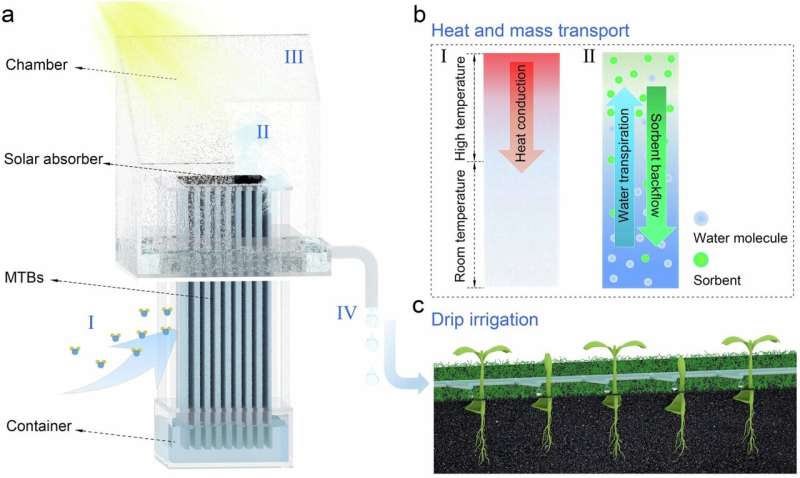
Freshwater scarcity affects over two billion people in the world, primarily in arid and remote regions, as well as islands and coastal areas without freshwater sources. Climate change and population growth are only making the problem worse, and existing methods require an energy input, usually electrical.
Renewable energy can fix this and is required for these regions for drinking water and irrigation, using water extracted from the atmosphere. (It is estimated the atmosphere holds about 13 trillion tons of water, six times the freshwater in the globe's rivers; global warming allows the air to hold more water vapor, by a theoretical 7% per degree Celsius of warming.)
Now engineers and scientists from Saudi Arabia and China have created a system that uses solar energy to extract as much as 3 liters (0.8 gallons) of water per square meter per day from air, in a purely passive way, requiring no maintenance or human operators. The study is published in the journal Nature Communications.
The system was tested by using its collected water to successfully grow cabbage during two seasons in Thuwal, Saudi Arabia.
"We aim to implement this technology to produce water from the air to compensate the water needs for sustainable agriculture required for secured food production in the Middle East," said Yu Han, a co-author from South China University of Technology.
Existing solar-driven atmospheric water extraction (SAWE) systems typically rely on absorbing water vapor from the air. When the absorbing material reaches saturation, the system is sealed and exposed to sunlight, which begins the release of the captured water. They are an improvement over passive atmospheric water technologies such as fog and dew collection, and more available in other geographies and sites with climate constraints.
But such SAWE systems allow only one absorption-release cycle per day, capturing moisture at night and desorbing in during the day, with the slow absorption phase limiting how much water can be extracted.
Their widespread adoption is also limited by costly absorbing nanomaterials, challenges scaling up prototypes, while switching cycles requires either an active system which is prone to breakdown or a labor-intensive operation with moving parts, making the systems complex and energy intensive.
To design a passive, efficient, easily scalable and minimal-labor system, the group used a structure of multiple vertical microchannels, called mass transport bridges. The tubes, sitting in a container, are filled with a liquid salt solution that acts as a liquid absorber; they used lithium chloride.
Depending on the temperature distribution, the ambient temperature region, exposed to the environment, continuously captures atmospheric water and stores it in a container. When the system receives sunlight, the absorber converts the light into heat and generates concentrated water vapor in the high-temperature region.
The water vapor condenses on the chamber wall, producing freshwater. More captured water from the absorber's container moves uninterrupted to the high-temperature region.
At the same time, the concentrated liquid in the high-temperature region is transported back to the ambient temperature region via diffusion—the movement of molecules from a region of high concentration to low concentration—and by convection—the movement of the hotter, lower density solution through the colder, denser regions—enabling continuous capture of water vapor as long as sunlight is available.
To implement this system, the team created a solar absorber out of partially oxidized carbon nanotubes onto a glass fiber membrane. The blackness of carbon nanotubes and the light-trapping microstructures absorbed about 96% of sunlight when wet. They found that the optimum heights for the vapor generation zone and atmospheric water capture zone were 3 and 5 cm, respectively.
To test this setup over an eight-day production period, they used eight hours of a sun's worth of illumination followed by 16 hours of darkness. They found that as the relative humidity increased from 60% to 90%, the water production rate increased from about 0.04 to about 0.65 kilograms per square meter per hour.
As a real-world test in the field in Saudi Arabia, the evaporation area was increased to 13.5 cm by 24 cm, 36 times larger than the prototype. This configuration produced 2.9 liters per square meter per day, varying by the solar energy received and the relative humidity.
This amount is four times larger than an atmospheric water project from 2021 and 27 times higher than a SAWE from 2017.
In a test in Papua New Guinea, this increased to 4.6 liters per square meter per day. "Remarkably, the harvested water was successfully utilized for off-grid irrigation of Brassica rapa (Chinese cabbage)," said co-author Qiaoqiang Gan from King Abdullah University of Science and Technology in Saudi Arabia, "demonstrating the potential for maintenance-free horticulture in areas without access to liquid water sources."
More information: Kaijie Yang et al, A solar-driven atmospheric water extractor for off-grid freshwater generation and irrigation, Nature Communications (2024). DOI: 10.1038/s41467-024-50715-0
© 2024 Science X Network
Citation: A passive, renewable, more efficient way to extract water from the atmosphere (2024, July 29) retrieved 29 July 2024 from https://techxplore.com/news/2024-07-passive-renewable-efficient-atmosphere.html
This document is subject to copyright. Apart from any fair dealing for the purpose of private study or research, no part may be reproduced without the written permission. The content is provided for information purposes only.
